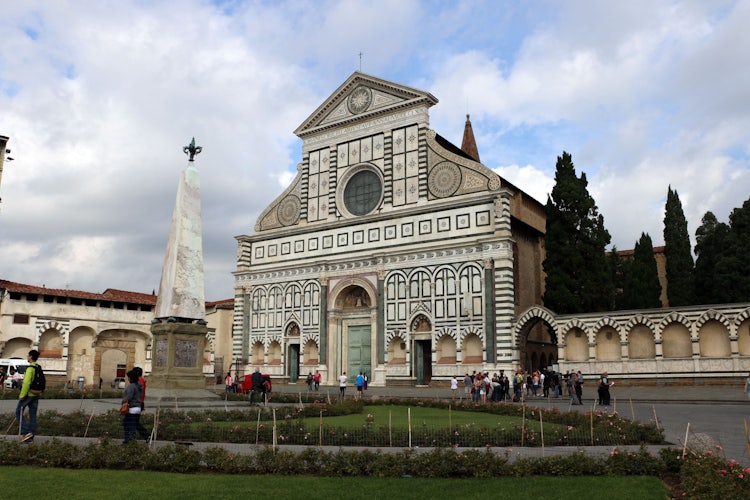 Florence – Santa Maria Novella
Florence – Santa Maria Novella
After crossing the street from the station square, you will find yourself on the edge of a zone free from high-speed traffic and exhaust fumes. On the other side of the Church of Santa Maria Novella - the back of which faces exactly the train station - lies a square with the lethargic atmosphere of some lost village, a popular place for open-air snacks and wandering around after dark. By contrast, a few blocks east of the station is Florence's main food market, lined with dozens of stalls stretching to the Church of San Lorenzo, which - like Santa Maria Novella - is also a very important monument.
Santa Maria Novella
Looking at the white and green patterns on the marble facade, you would never have guessed, that the Church of Santa Maria Novella (pn.-sb. 7.15-11.30 i 15.30-17.00, nd. 15.30-17.00) was the Florentine seat of the Dominican Order, the strict guards of 13th-century Catholicism. The church was built at the end of the 11th century. and shortly thereafter handed over to the Dominicans, who began to rebuild it to their own taste.
Do 1360 r. the entire interior was completed, but only the lower part of the façade was completed and this was the case until 1456 r., when Giovanni Rucellai paid Alberti for the design of the classicising upper part, which would be in harmony with the older one, and at the same time improved the proportions of the facade.
The architects of the gothic interior were also capable of great virtuosity, the distance between the columns decreases towards the altar, what causes, that from the entrance the nave seems longer than it really is. Remarkable fresco of Masaccia Holy Trinity (1428), belonging to the earliest works, in which the perspective and classic proportions are strictly adhered to, it was painted on the wall halfway along the left aisle. In the main part of the church, nothing is so impressive anymore, but the richness of decorations from the side of the presbytery is astonishing. Filippo Strozzi chapel (directly to the right of the presbytery) it is covered with a series of frescoes commissioned by Strozzi from Filippin Lippi in 1486 r. and completed fifteen years later, after the artist's stay in Rome; a fairy-tale vision of the classic ruins of Lippi, in which the narrative often seems to recede into the background, is one of the first examples of archaeological interest in Roman ruins. As a chronicle of 15th-century life in Florence, no cycle of frescoes is as fascinating as the paintings by Domenico Ghirlandaio behind the main altar; the work was commissioned by Giovanni Tomabuoni, which explains, why some noble ladies of the Tomabuoni family are present at the birth of John the Baptist and the Virgin Mary.
Brunelleschi's crucifix, which is believed, that he was carved as a lesson to Donatello, it hangs to the left of the presbytery. At the end of the left transept, the Cappella Strozzi is raised, whose faded frescoes by Narda di Cione (can 1350-tea) cover the entire wall of commentary on Dante's Inferno. A magnificent altar painting of Brother Nard, Andrei (better known as Orcagna), is a tribute to the Dominicans - Christ blesses St.. Peter and St.. Thomas Aquinas, characters, which in the Dominican hierarchy was second only to St.. Dominik.
CURVES
Krużganki Santa Maria Novella (Mon-Thu. i sob. 9.00-14.00, nd. 8.00-13.00; 2000 L, nd. Free entrance), the entrance to the left of the church facade, they are more ornate than any other in Florentine. Paolo Uccello and his associates painted the frescoes in the Romanesque Chiostro Verde - on the right from the entrance is an image of the stormy waters of the Deluge and its effects. Chapel of the Spaniards (Spanish Chapel), former chapter house, owes its new name to Eleonora of Toledo, who reserved the chapel for its Spanish entourage; a series of frescoes by Andrea da Firenze, showing the triumph of the Catholic Church, was described by Ruskin as "the most sublime work of painting philosophy in Italy". His performance of the duomo was purely speculative — the cycle dates from 1360 r., long before Brunelleschi won the vault competition. Coming from the same period, but the more exposed decoration of Chiostrino dei Morti, the oldest part of the complex, it has not lost its value with age.
Fair
One of the monuments of Florence, which cannot be omitted, is Mercato Centrale in the area of San Lorenzo, built in stone, iron and glass by Giuseppe Mengoni, the architect of the Milan Gallery. It was opened in 1874 r "a year 1980, as a result of renovation, he gained one floor. Butchers, food, flakers, target eniarze (on the first floor), spaghetti sales stands, bars - all this is gathered under one roof, and the prices are lower than anywhere in the city. The market is open from Monday to Friday 7.00-14.00, and on Saturdays and pre-holiday days additionally from 16.00 do 20.00. At the end of the working day, you can buy a lot of things at really bargain prices. Then in Ottavino, little bar, where market workers traditionally meet (from the side of via dell'Ariento, open until 13.30), you can try simple Florentine cuisine at its best.
Every day from 8.00 do 19.00 the streets around Mercato Centrale are teeming with stalls selling bags, stripes, shoes - everything, what you may miss in your wardrobe. It is one of the busiest street markets in Florence and it is a delight to all but the unrepentant misanthropes to immerse yourself in a crowd of ferocious bargains for half an hour. However, the market is not the cheapest - at the stands in Piazza delle Cure, zarazza Piazza della Liberta (every morning; bus no 1) and at the huge market on Tuesdays mornings in Cascine Park, westbound over the Arno (bus no 16), you can find real bargains.